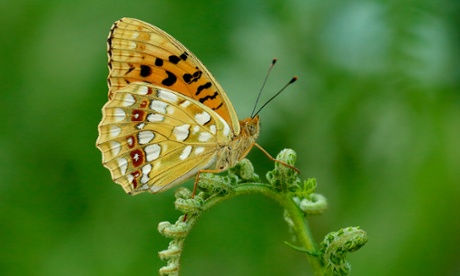Britain's farmland butterflies have declined by 30% over the last 10 years, according to a government study today, which ministers admit has "worrying" implications for the ecosystem.
Researchers from Butterfly Conservation looked at 40 butterfly species on more than 800 sites. They found a 30% fall in butterfly numbers across the board, including on sites that have been targeted for conservation.
Their report for the Department for Environment, Food and Rural Affairs also found some evidence that the decline had accelerated in the last three years of the 10-year study.
It concluded: "Because butterflies are widely accepted as good indicators of ecosystem health, the overall decline is an alarming result with important implications for other insects and biodiversity."
Sir David Attenborough, chairman of Butterfly Conservation, said: "The declines of butterflies are deeply concerning, especially in light of the recently published declines of common moths. Together, these losses indicate that we are entering a deep biodiversity crisis that needs the urgent attention of us all."
Announcing the findings, the biodiversity minister, Jim Knight, said: "Butterflies are an iconic species in their own right, and they can be good indicators of the health of the entire ecosystem, so this decline is worrying."
The study found that a general approach to conservation, over the last 10 years, had often harmed butterfly habitats. Land managers have tended to promote a uniform diversity of flowers and shrubs in conservation areas, which has not always suited the often fussy requirements of butterfly species.
It said: "General conservation measures aimed at conserving birds and improving habitat have not been sufficient to halt butterfly declines. Moreover, for some species types they may have exacerbated declines."
The species that were declining included the Small Blue, Grizzled Skipper, Green Hairstreak and Duke of Burgundy. These are all "mosaic" species because they require varied habitats.
But the study revealed more encouraging findings where the specific habitat of endangered species had been targeted for protection.
As part of commitments made at the 1992 Rio earth summit, the government agreed to single out eight butterfly species for special protection as part of a biodiversity action plan.
Today's study found significant improvements in four of these species; the Adonis Blue, High Brown Fritillary, Heath Fritillary and Silver-studded Blue. Of the other four, the population of the Pearl-bordered Fritillary and Silver-spotted Skipper had stabilised. But the Marsh Fritillary and the Northern Brown Argus continued to decline despite efforts to improve habitats which they relied on.
Mr Knight said the government was now promoting a more targeted approach to protect individual species under its environmental stewardship scheme.
He said the scheme "has the potential to address many of the concerns highlighted in this report, and could make a big difference to butterflies and to all the other insects, mammals and birds that rely on them".
· In pictures: Winners and losers in the bid to conserve Britain's declining lepidopteran population








